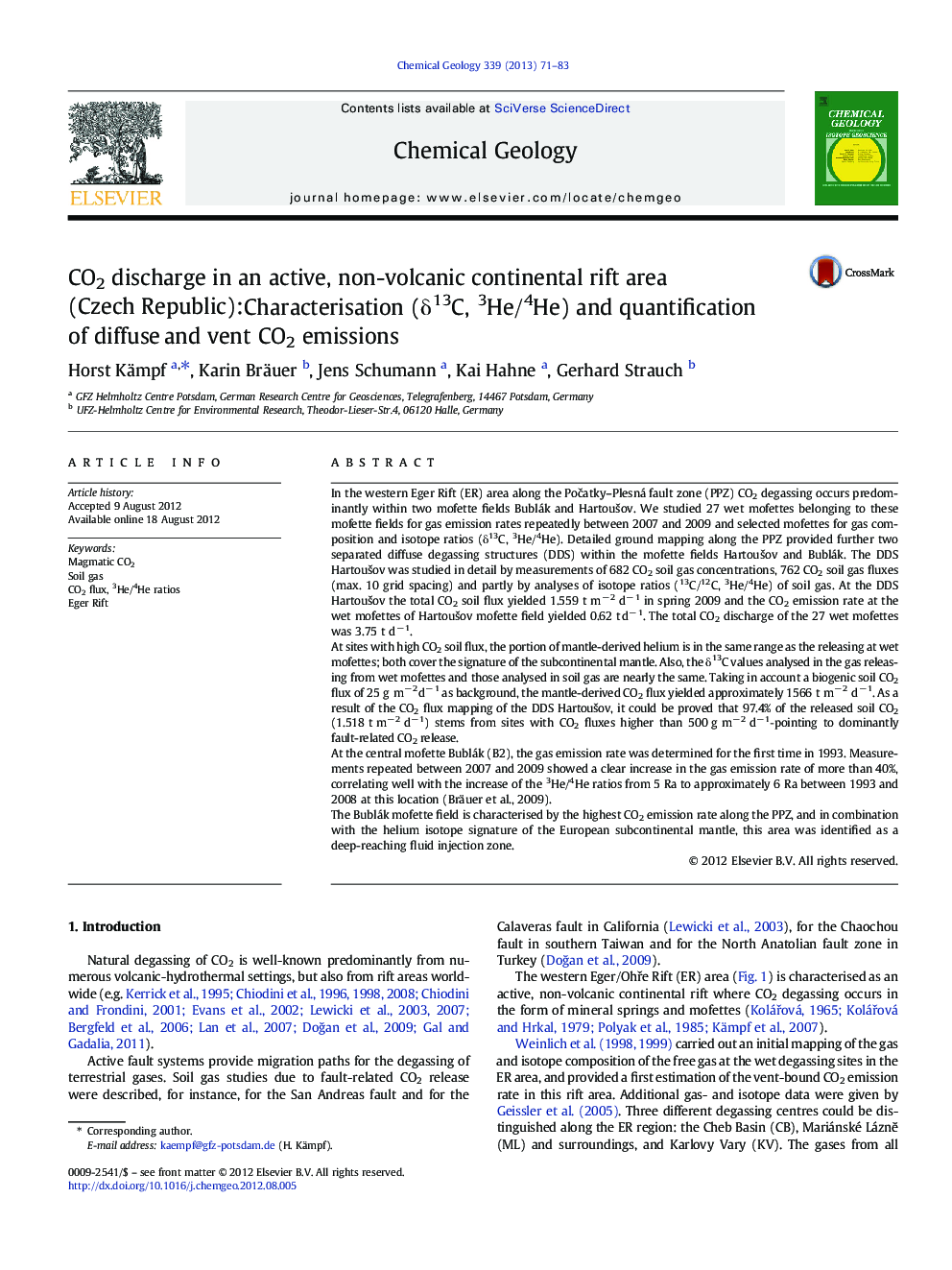| کد مقاله | کد نشریه | سال انتشار | مقاله انگلیسی | نسخه تمام متن |
|---|---|---|---|---|
| 4699127 | 1637629 | 2013 | 13 صفحه PDF | دانلود رایگان |

In the western Eger Rift (ER) area along the Počatky–Plesná fault zone (PPZ) CO2 degassing occurs predominantly within two mofette fields Bublák and Hartoušov. We studied 27 wet mofettes belonging to these mofette fields for gas emission rates repeatedly between 2007 and 2009 and selected mofettes for gas composition and isotope ratios (δ13C, 3He/4He). Detailed ground mapping along the PPZ provided further two separated diffuse degassing structures (DDS) within the mofette fields Hartoušov and Bublák. The DDS Hartoušov was studied in detail by measurements of 682 CO2 soil gas concentrations, 762 CO2 soil gas fluxes (max. 10 grid spacing) and partly by analyses of isotope ratios (13C/12C, 3He/4He) of soil gas. At the DDS Hartoušov the total CO2 soil flux yielded 1.559 t m− 2 d− 1 in spring 2009 and the CO2 emission rate at the wet mofettes of Hartoušov mofette field yielded 0.62 t d− 1. The total CO2 discharge of the 27 wet mofettes was 3.75 t d− 1.At sites with high CO2 soil flux, the portion of mantle-derived helium is in the same range as the releasing at wet mofettes; both cover the signature of the subcontinental mantle. Also, the δ13C values analysed in the gas releasing from wet mofettes and those analysed in soil gas are nearly the same. Taking in account a biogenic soil CO2 flux of 25 g m− 2 d− 1 as background, the mantle-derived CO2 flux yielded approximately 1566 t m− 2 d− 1. As a result of the CO2 flux mapping of the DDS Hartoušov, it could be proved that 97.4% of the released soil CO2 (1.518 t m− 2 d− 1) stems from sites with CO2 fluxes higher than 500 g m− 2 d− 1‐pointing to dominantly fault-related CO2 release.At the central mofette Bublák (B2), the gas emission rate was determined for the first time in 1993. Measurements repeated between 2007 and 2009 showed a clear increase in the gas emission rate of more than 40%, correlating well with the increase of the 3He/4He ratios from 5 Ra to approximately 6 Ra between 1993 and 2008 at this location (Bräuer et al., 2009).The Bublák mofette field is characterised by the highest CO2 emission rate along the PPZ, and in combination with the helium isotope signature of the European subcontinental mantle, this area was identified as a deep-reaching fluid injection zone.
► We quantified the mantle-derived CO2 flux along a seismically active fault zone.
► The portion of diffuse CO2 degassing was higher than that of CO2 vent degassing.
► The δ13C values and 3He/4He ratios of vent and diffuse degassing are nearly the same.
► Isotope (C, He) and CO2 flux measurements depict highly permeable fluid conduits.
► Bublák mofette represents a fluid-injection zone reaching up to lithospheric mantle.
Journal: Chemical Geology - Volume 339, 15 February 2013, Pages 71–83